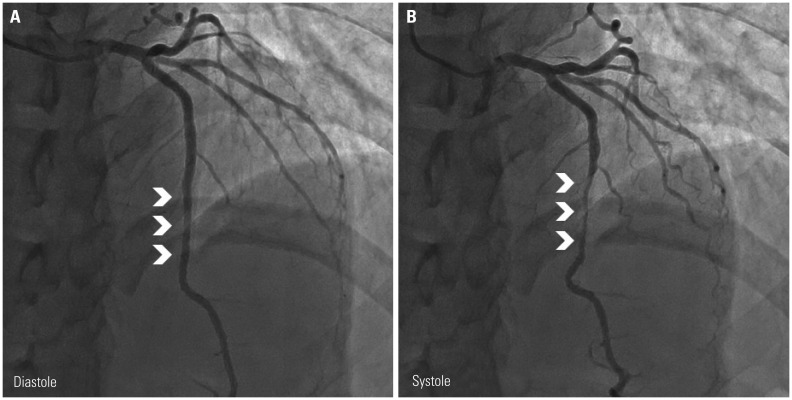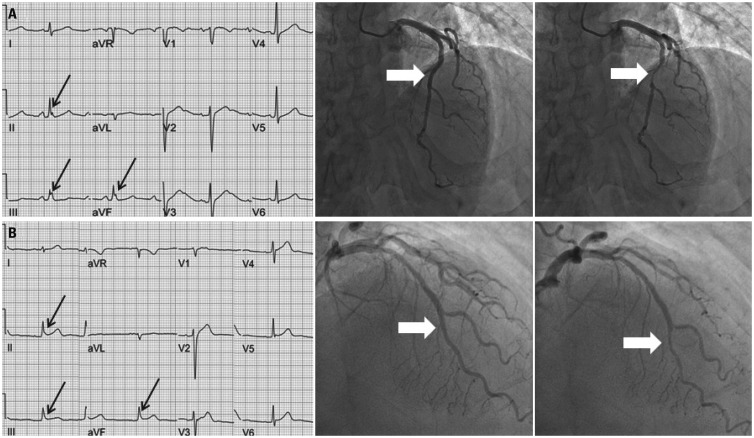Yonsei Med J.
2017 Jan;58(1):67-74. 10.3349/ymj.2017.58.1.67.
High Prevalence and Clinical Implication of Myocardial Bridging in Patients with Early Repolarization
- Affiliations
-
- 1Department of Internal Medicine, Division of Cardiology, Yonsei University College of Medicine, Seoul, Korea. cby6908@yuhs.ac
- 2Department of Internal Medicine, Division of Cardiology, Ewha Womans University, Seoul, Korea.
- 3Department of Internal Medicine, Division of Cardiology, Bundang CHA Medical Center, CHA University, Seongnam, Korea.
- KMID: 2374190
- DOI: http://doi.org/10.3349/ymj.2017.58.1.67
Abstract
- PURPOSE
Recent evidence suggests that early repolarization (ER) is related with myocardial ischemia. Compression of coronary artery by a myocardial bridging (MB) can be associated with clinical manifestations of myocardial ischemia. This study aimed to evaluate the associations of MB in patients with ER.
MATERIALS AND METHODS
In consecutive patients (n=1303, age, 61±12 years) who had undergone coronary angiography, we assessed the prevalence and prognostic implication of MB in those with ER (n=142) and those without ER (n=1161).
RESULTS
MB was observed in 54 (38%) and 196 (17%) patients in ER and no-ER groups (p<0.001). In multivariate analysis, MB was independently associated with ER (odd ratio: 2.9, 95% confidence interval: 1.98-4.24, p<0.001). Notched type ER was more frequently observed in MB involving the mid portion of left anterior descending coronary artery (LAD) (69.8% vs. 30.2%, p=0.03). Cardiac event was observed in nine (6.3%) and 22 (1.9%) subjects with and without ER, respectively. MB was more frequently observed in sudden death patients with ER (2 out of 9, 22%) than in those without ER (0 out of 22).
CONCLUSION
MB was independently associated with ER in patients without out structural heart disease who underwent coronary angiography. Notched type ER was closely related with MB involving the mid portion of the LAD. Among patients who had experienced cardiac events, a higher prevalence of MB was observed in patients with ER than those without ER. Further prospective studies on the prognosis of MB in ER patients are required.
Keyword
MeSH Terms
Figure
Reference
-
1. Klatsky AL, Oehm R, Cooper RA, Udaltsova N, Armstrong MA. The early repolarization normal variant electrocardiogram: correlates and consequences. Am J Med. 2003; 115:171–177. PMID: 12935822.
Article2. Haïssaguerre M, Derval N, Sacher F, Jesel L, Deisenhofer I, de Roy L, et al. Sudden cardiac arrest associated with early repolarization. N Engl J Med. 2008; 358:2016–2023. PMID: 18463377.
Article3. Nam GB, Kim YH, Antzelevitch C. Augmentation of J waves and electrical storms in patients with early repolarization. N Engl J Med. 2008; 358:2078–2079. PMID: 18463391.
Article4. Tikkanen JT, Anttonen O, Junttila MJ, Aro AL, Kerola T, Rissanen HA, et al. Long-term outcome associated with early repolarization on electrocardiography. N Engl J Med. 2009; 361:2529–2537. PMID: 19917913.
Article5. Oh CM, Oh J, Shin DH, Hwang HJ, Kim BK, Pak HN, et al. Early repolarization pattern predicts cardiac death and fatal arrhythmia in patients with vasospastic angina. Int J Cardiol. 2013; 167:1181–1187. PMID: 22483625.
Article6. Inoue M, Matsubara T, Yasuda T, Miwa K, Kanaya H. Transition of the ST segment from a J wave to a coved-type elevation before ventricular fibrillation induced by coronary vasospasm in the precordial leads. J Electrocardiol. 2010; 43:418–421. PMID: 20667548.
Article7. Möhlenkamp S, Hort W, Ge J, Erbel R. Update on myocardial bridging. Circulation. 2002; 106:2616–2622. PMID: 12427660.
Article8. Patel RB, Ng J, Reddy V, Chokshi M, Parikh K, Subacius H, et al. Early repolarization associated with ventricular arrhythmias in patients with chronic coronary artery disease. Circ Arrhythm Electrophysiol. 2010; 3:489–495. PMID: 20657030.
Article9. Antzelevitch C, Brugada P, Borggrefe M, Brugada J, Brugada R, Corrado D, et al. Brugada syndrome: report of the second consensus conference: endorsed by the Heart Rhythm Society and the European Heart Rhythm Association. Circulation. 2005; 111:659–670. PMID: 15655131.10. JCS Joint Working Group. Guidelines for diagnosis and treatment of patients with vasospastic angina (coronary spastic angina) (JCS 2008): digest version. Circ J. 2010; 74:1745–1762. PMID: 20671373.11. Mookadam F, Green J, Holmes D, Moustafa SE, Rihal C. Clinical relevance of myocardial bridging severity: single center experience. Eur J Clin Invest. 2009; 39:110–115. PMID: 19200164.
Article12. Landis JR, Koch GG. The measurement of observer agreement for categorical data. Biometrics. 1977; 33:159–174. PMID: 843571.
Article13. Macfarlane PW, Antzelevitch C, Haissaguerre M, Huikuri HV, Potse M, Rosso R, et al. The early repolarization pattern: a consensus paper. J Am Coll Cardiol. 2015; 66:470–477. PMID: 26205599.14. Meregalli PG, Wilde AA, Tan HL. Pathophysiological mechanisms of Brugada syndrome: depolarization disorder, repolarization disorder, or more? Cardiovasc Res. 2005; 67:367–378. PMID: 15913579.
Article15. Ishikawa Y, Kawawa Y, Kohda E, Shimada K, Ishii T. Significance of the anatomical properties of a myocardial bridge in coronary heart disease. Circ J. 2011; 75:1559–1566. PMID: 21467656.
Article16. Myerburg RJ, Kessler KM, Mallon SM, Cox MM, deMarchena E, Interian A Jr, et al. Life-threatening ventricular arrhythmias in patients with silent myocardial ischemia due to coronary-artery spasm. N Engl J Med. 1992; 326:1451–1455. PMID: 1574091.
Article17. Amsterdam EA. Relation of silent myocardial ischemia to ventricular arrhythmias and sudden death. Am J Cardiol. 1988; 62:24I–27I.
Article18. Yan GX, Antzelevitch C. Cellular basis for the Brugada syndrome and other mechanisms of arrhythmogenesis associated with ST-segment elevation. Circulation. 1999; 100:1660–1666. PMID: 10517739.
Article19. Haïssaguerre M, Chatel S, Sacher F, Weerasooriya R, Probst V, Loussouarn G, et al. Ventricular fibrillation with prominent early repolarization associated with a rare variant of KCNJ8/KATP channel. J Cardiovasc Electrophysiol. 2009; 20:93–98. PMID: 19120683.20. Gawor R, Kuśmierek J, Płachcińska A, Bieńkiewicz M, Drożdż J, Piotrowski G, et al. Myocardial perfusion GSPECT imaging in patients with myocardial bridging. J Nucl Cardiol. 2011; 18:1059–1065. PMID: 21822768.
Article21. Feldman AM, Baughman KL. Myocardial infarction associated with a myocardial bridge. Am Heart J. 1986; 111:784–787. PMID: 3953402.
Article22. Alegria JR, Herrmann J, Holmes DR Jr, Lerman A, Rihal CS. Myocardial bridging. Eur Heart J. 2005; 26:1159–1168. PMID: 15764618.
Article23. Yan GX, Antzelevitch C. Cellular basis for the electrocardiographic J wave. Circulation. 1996; 93:372–379. PMID: 8548912.
Article24. Liu DW, Gintant GA, Antzelevitch C. Ionic bases for electrophysiological distinctions among epicardial, midmyocardial, and endocardial myocytes from the free wall of the canine left ventricle. Circ Res. 1993; 72:671–687. PMID: 8431990.
Article25. Ishii T, Hosoda Y, Osaka T, Imai T, Shimada H, Takami A, et al. The significance of myocardial bridge upon atherosclerosis in the left anterior descending coronary artery. J Pathol. 1986; 148:279–291. PMID: 3701494.
Article26. Ishii T, Asuwa N, Masuda S, Ishikawa Y, Kiguchi H, Shimada K. Atherosclerosis suppression in the left anterior descending coronary artery by the presence of a myocardial bridge: an ultrastructural study. Mod Pathol. 1991; 4:424–431. PMID: 1924274.27. Ishikawa Y, Akasaka Y, Suzuki K, Fujiwara M, Ogawa T, Yamazaki K, et al. Anatomic properties of myocardial bridge predisposing to myocardial infarction. Circulation. 2009; 120:376–383. PMID: 19620504.
Article28. Aizawa Y, Sato M, Kitazawa H, Aizawa Y, Takatsuki S, Oda E, et al. Tachycardia-dependent augmentation of "notched J waves" in a general patient population without ventricular fibrillation or cardiac arrest: not a repolarization but a depolarization abnormality? Heart Rhythm. 2015; 12:376–383. PMID: 25460863.
Article
- Full Text Links
- Actions
-
Cited
- CITED
-
- Close
- Share
- Similar articles
-
- A Case of Q Wave Acute Myocardial Infarction in Patients with Myocardial Bridging Caused by Fibrous Band
- A Totally Occluded Long Segment Myocardial Bridge: 10-year Follow-up after Percutaneous Coronary Intervention in a Patient with Hypertrophic Cardiomyopathy
- An Overview of Myocardial Bridging With a Focus on Multidetector CT Coronary Angiographic Findings
- Surgery for Myocardial Bridging: A report of two cases
- Dispersion of QT Interval and Other Repolarization Indexes in Acute Myocardial Infarction



